Neilson Surname Ancestry ResultsOur indexes 1000-1999 include entries for the spelling 'neilson'. In the period you have requested, we have the following 448 records (displaying 301 to 310): Single Surname Subscription | | | Buying all 448 results of this search individually would cost £2,530.00. But you can have free access to all 448 records for a year, to view, to save and print, for £100. Save £2,430.00. More... |
These sample scans are from the original record. You will get scans of the full pages or articles where the surname you searched for has been found. Your web browser may prevent the sample windows from opening; in this case please change your browser settings to allow pop-up windows from this site. Long-Lost Relatives: Home Inquiries
(1900)
Each issue of Lloyd's Weekly News, of London, contained a column devoted to searches for Long-Lost Relatives. The inquiries were arranged in three groups: Home Inquiries (i. e., from correspondents in the United Kingdom); Colonial and Foreign Inquiries (from abroad); and Soldiers' and Sailors' Inquiries. Results from all these were grouped together as 'Answers to Inquiries'.
Each column was headed: 'Correspondents MUST give full addresses and the DATES OF THE INQUIRIES to which they refer. We cannot search back numbers, nor print inquiries for "missing husbands." These columns are not intended for inquiries in respect to claimants for money, and no agents, at home or abroad, have any connection with Lloyd's.'NEILSON. Cost: £6.00.  | Sample scan, click to enlarge

| Missing Next-of-Kin and Heirs-at-Law
(1900)
The Unclaimed Money Registry and Next-of-Kin Advertisement Office of F. H. Dougal & Co., on the Strand in London, published a comprehensive 'Index to Advertisements for Next of Kin, Heirs at Law, Legatees, &c., &c., who have been Advertised for to Claim Money and Property in Great Britain and all Parts of the World; also Annuitants, Shareholders, Intestates, Testators, Missing Friends, Creditors or their Representatives, Claimants, Unclaimed and Reclaimed Dividends and Stock, Citations, Administrations, Rewards for Certificates, Wills, Advertisements, &c., Claims, Unclaimed Balances, Packages, Addresses, Parish Clerks' Notices, Foreign Intestates, &c., &c.' The original list was compiled about 1880, but from materials dating back even into the 18th century: most of the references belong to 1850 to 1880. For each entry only a name is given, sometimes with a placename added in brackets: there may be a reference number, but there is no key by which the original advertisement may be traced. The enquirer of the time had to remit £1 for a 'Full and Authentic Copy of the Original Advertisement, together with name and date of newspaper in which the same appeared'. This appendix to the list was issued in about 1900.NEILSON. Cost: £4.00.  | Sample scan, click to enlarge

|  Outstanding soldiers of the Manchester Regiment
(1881-1901) Outstanding soldiers of the Manchester Regiment
(1881-1901)
Each year the best soldiers of the regiment were chosen for long service and good conduct medals. This register gives rank, name, regimental number, and date of recommendation. (The sample scan is from the East Surrey regiment). The register is essentially a register of recommendations, annotated with details of the issue of the medals. Where no gratuity accompanied the medal, the entry is marked 'W. G.' (without gratuity); where, for one reason or another, the medal was not issued, the entry is marked 'N. S.' (not sanctioned) and struck through. The regiment was based on the 63rd Regimental District - Ashton-under-Lyne. The 1st battalion was in Bengal until 1882, when it was transferred to Egypt, adding "Egypt, 1882" to the regimental honours. It returned to England at the end of 1882, and in 1885 was at Shorncliffe; was moved to Ireland in 1888; back to England in 1894; and in 1895 was stationed at Preston. In 1897 the battalion set sail for Gibraltar, and in 1899 was sent on to South Africa, winning the distinctions "South Africa, 1899-1902" and "Defence of Ladysmith". The 2nd battalion embarked for Malta in 1881, was moved from there to Egypt in 1882, joining the 1st battalion in the Egyptian campaign; and from there in October 1882 to India: in 1885 it was stationed at Mooltan, and by 1895 at Dinapore. The 2nd battalion took part in the Miranzai expedition of 1891. It was transferred to Aden in 1897, and back to England in 1898, being moved the following year to Ireland, and then in 1900 to South Africa, also taking part in the Boer war of 1900 to 1902.NEILSON. Cost: £8.00.  | Sample scan, click to enlarge
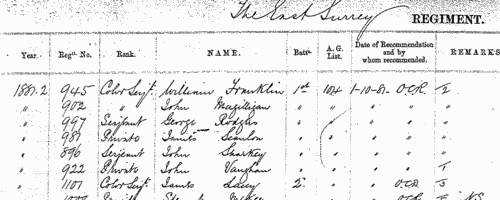
|  Outstanding soldiers of the Royal Welsh Fusiliers
(1881-1901) Outstanding soldiers of the Royal Welsh Fusiliers
(1881-1901)
Each year the best soldiers of the regiment were chosen for long service and good conduct medals. This register gives rank, name, regimental number, and date of recommendation. (The sample scan is from the East Surrey regiment). The register is essentially a register of recommendations, annotated with details of the issue of the medals. Where no gratuity accompanied the medal, the entry is marked 'W. G.' (without gratuity); where, for one reason or another, the medal was not issued, the entry is marked 'N. S.' (not sanctioned) and struck through. The regiment was based on the 23rd Regimental District - Wrexham. The 1st battalion embarked for Bengal in 1880, and by 1885 was stationed at Dum Dum; it was transferred to Burma for the campaign of 1885 to 1886 ("Burma, 1885-1887"), returning to India in 1887. The battalion took part in the Hazara Expedition of 1891. In 1895 it was at Jhansi. The troops returned to England via Aden in 1897, but were dispatched to South Africa in 1899, where they added "South Africa, 1899-1900" and "Relief of Ladysmith" to the regimental honours. The 2nd battalion returned to England from Gibraltar in 1880, was transferred to Ireland in 1883, and was at Templemore in 1885. The battalion returned to England in 1892, and was at Manchester in 1895. In 1896 the 2nd battalion was sent out to Malta, where it took part in the occupation of Crete; and on to Hong Kong in 1898, fighting in China and adding "Pekin, 1900" to the colours.NEILSON. Cost: £8.00.  | Sample scan, click to enlarge
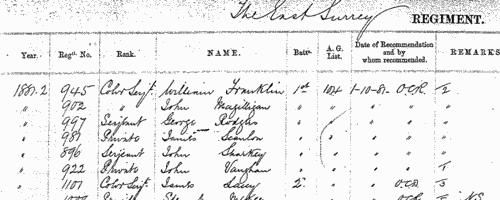
|  Outstanding soldiers of the South Wales Borderers
(1881-1901) Outstanding soldiers of the South Wales Borderers
(1881-1901)
Each year the best soldiers of the regiment were chosen for long service and good conduct medals. This register gives rank, name, regimental number, and date of recommendation. (The sample scan is from the East Surrey regiment). The register is essentially a register of recommendations, annotated with details of the issue of the medals. Where no gratuity accompanied the medal, the entry is marked 'W. G.' (without gratuity); where, for one reason or another, the medal was not issued, the entry is marked 'N. S.' (not sanctioned) and struck through. The regiment was based on the 24th Regimental District - Brecon. The 1st battalion returned from Malta in 1879, and by 1885 was stationed at Kilkenny. It embarked for Egypt 17 December 1892. The 2nd battalion embarked for the Cape of Good Hope in February 1878, and from South Africa moved on to India, and was established at Fort St George in Madras by 1885. Joining in the Burmese campaign it won the honour "Burma, 1885-1887" for the regiment. The battalion returned to England (via Aden) 16 November 1893, and in 1895 was stationed at Gosport. The regiment took part in the South African war, adding "South Africa, 1900-1902" to the colours.NEILSON. Cost: £8.00.  | Sample scan, click to enlarge
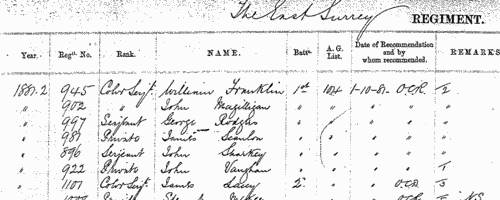
| Boys entering Uppingham School
(1901)
The public school at Uppingham in Rutland was founded by Archdeacon Johnson in 1584. A roll of scholars from 1824 to 1905 was edited by J. P. Graham, and published in 1906. This was a revision and updating of an 1894 edition of the roll, the great bulk of the work having been done by Mrs Mullins. The roll is arranged by year, and within each year by term of entrance, and then alphabetically by surname within each term. Each boy's name is given, surname first, with an asterisk where known (in 1906) to have died. Then there is month and year of birth, father's name (most often just surname and initials) and address (at entrance). Where the boy represented the school at Rugby football (XV) or cricket (XI), that is indicated. After the month and year of leaving the school, there is a brief summary of achievements in later life, and, where known, address as in 1906; but as late as this year, most boys were still at school and the entries are brief. From 1875 onwards the house within the school is also noted, with these abbreviations: A., Mr Constable's House; B., Brooklands; C., West Bank; E., Mr J. Gale Thring's House; F., Fircroft; Fgh., Farleigh; H., Highfield; L., The Lodge; L. H., Lorne House; M., Meadhurst; N., The Hall; R., Redgate; R. H., Red House; S., School House; and W. D., West Deyne.NEILSON. Cost: £4.00.  | Sample scan, click to enlarge
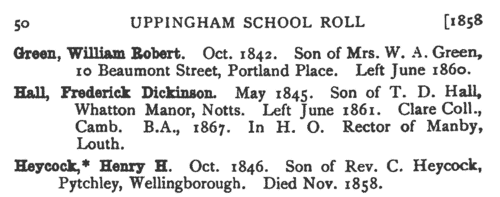
|  London Metropolitan Police
(1892-1902) London Metropolitan Police
(1892-1902)
The London Metropolitan Police Register of Joiners (MEPO 4/336) lists policemen joining the force 1 January 1892 to 23 June 1902 (warrant numbers 77319 to 88811). The register is alphabetical, in so far as the recruits are listed chronologically grouped under first letter of surname. It gives Date of Appointment, Name, Number of Warrant, Cause of Removal from Force (resigned, dismissed, promoted or died), and Date of Removal. A final column of 'Remarks' is largely blank, but occasionally gives an alias or a cross-reference to another warrant number.NEILSON. Cost: £8.00.  | Sample scan, click to enlarge

|  British artillerymen fighting in South Africa
(1899-1902) British artillerymen fighting in South Africa
(1899-1902)
The Queen Victoria's South Africa Medal was awarded (after her death, in the event) to all who had served honourably in the various campaigns in the Boer War. Returns were made from each unit, and consolidated into nominal roll, of which this is the one for the Royal Artillery. Confusingly, the ledgers used had originally been printed for a register of men transferred (or re-transferred after mobilization) to 1st Class Army Reserve. All the original column headings were therefore struck through, and the roll was prepared with this information: Date of Issue; Regimental Number; Rank; Name; Unit; Medal (a 1 indicating that a medal was awarded); [number of] Clasps; the reference to the source in the original returns, usually starting with AG for papers in the hands of the Adjutant-General, and 68/Art/ for the Royal Artillery records. The final column, normally left blank, was occasionally used for explanatory remarks.NEILSON. Cost: £8.00.  | Sample scan, click to enlarge

| Boys entering Uppingham School
(1902)
The public school at Uppingham in Rutland was founded by Archdeacon Johnson in 1584. A roll of scholars from 1824 to 1905 was edited by J. P. Graham, and published in 1906. This was a revision and updating of an 1894 edition of the roll, the great bulk of the work having been done by Mrs Mullins. The roll is arranged by year, and within each year by term of entrance, and then alphabetically by surname within each term. Each boy's name is given, surname first, with an asterisk where known (in 1906) to have died. Then there is month and year of birth, father's name (most often just surname and initials) and address (at entrance). Where the boy represented the school at Rugby football (XV) or cricket (XI), that is indicated. After the month and year of leaving the school, there is a brief summary of achievements in later life, and, where known, address as in 1906; but as late as this year, most boys were still at school and the entries are brief. From 1875 onwards the house within the school is also noted, with these abbreviations: A., Mr Constable's House; B., Brooklands; C., West Bank; E., Mr J. Gale Thring's House; F., Fircroft; Fgh., Farleigh; H., Highfield; L., The Lodge; L. H., Lorne House; M., Meadhurst; N., The Hall; R., Redgate; R. H., Red House; S., School House; and W. D., West Deyne.NEILSON. Cost: £4.00.  | Sample scan, click to enlarge
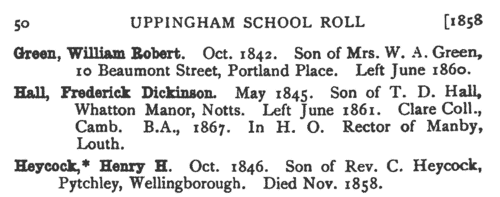
| Boys entering Loretto School
(1903)
The Reverend Dr Thomas Langhorne, who came to Musselburgh in Midlothian as an Episcopalian Church clergyman, established a small school for boarders and day scholars at Loretto House, so called because the grounds contained the ruins of the mediaeval chapel of St Mary of Loretto. To celebrate the centenary of the school in 1925, a second edition of the school register was published, edited by A. H. Buchanan-Dunlop. Relatively little was known of many of the earliest scholars, but from 1835 onwards the register generally gives full name, in capitals, surname first; date of birth; period of time at Loretto; a brief biography; date of death; whether brother of any other boy in the register; and a sequential number. NEILSON. Cost: £4.00.  | Sample scan, click to enlarge
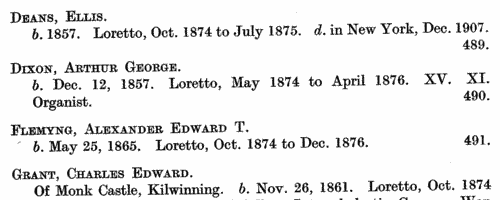
|
Research your ancestry, family history, genealogy and one-name study by direct access to original records and archives indexed by surname.
|













